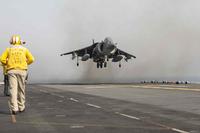The Obama administration released its DoD budget today for FY 2010, requesting $533.7 billion, a 4 percent increase over the 2009 budget of $513 billion. If funded, the 2010 budget would be the highest defense budget in real terms since World War II, exceeding even the peak years of the Reagan era defense build-up.
The increase supports Obama’s desire to expand the ground forces to 547,400 soldiers and 202,000 Marines by the end of 2009. The administration also wants $130 billion for the wars in Iraq and Afghanistan for 2010, down from $144 being spent this year.
The budget outline provided by the White House says the administration intends to focus on the military’s “internal” challenges, these include: restructure the force to better address long-term security challenges; care, compensation and benefits protection for troops and their families; and reform weapons development and acquisition. The administration promises to match spending to strategic goals “in an upcoming Defense Review.”
The budget request includes a proposed pay increase of 2.9 percent and pay and benefits that “keep pace with or exceed those of the private sector.” It doesn’t specify which career path in the private sector. It lists a number of proposed benefits expansions for retirees and veterans including disability compensation, mental health care, as well as military housing and base improvements.
It says the budget will include “placeholder” estimates of $50 billion per year for 2011 and beyond for war costs, although it says those estimates are subject to change. That figure would be consistent with the administration’s stated goal of achieving savings through winding down the war in Iraq. The budget proposal moves into the base budget a number of items previously paid for by emergency supplementals, such as security assistance to foreign governments and various aerial sensor and other intelligence programs.
While the 2010 request is an increase over 2009, if you’re a weapons builder, the $533 billion figure is bad news. Here’s why:
DOD’s base budget for 2009 was $518 billion. That included $309 billion for operations and support activities, including $129 billion in personnel costs and $180 billion in the operations and maintenance accounts, which includes civilian military pay and costs to run the military on a daily basis, such as base operations, most military healthcare and equipment operations and maintenance. Those personnel costs are clearly going up.
Also, Obama’s budget will begin to move expenses that had been paid for in the supplementals into the base budget’s operations and support accounts. Those expenses will likely include reset costs, repairing the Army and Marine’s war worn battle fleet, likely to carry at least a $15 billion a year price tag for the next few years. If the administration plans to drop supplemental war costs to $50 billion a year, including an increased troop presence in Afghanistan, then reset costs will not be funded through the supplementals.
So that 60 percent or so of the DOD budget is not only off limits to any future trimming but will in fact expand. There’s a good chance that the 4 percent increase in the 2010 defense budget will occur entirely in those operations and support accounts. The Congressional Bugdet Office projected that the operations and support accounts, driven primarily by rising personnel costs, would increase to somewhere around $342-352 billion.
That leaves the acquisition budget, which consists of the research and development and procurement accounts as the only place to acheive any cost savings. In the 2009 budget, acquisition costs totaled $184 billion. CBO estimated that DOD could develop and build those weapons it has in the pipeline, if costs can be controlled, for about $185 billion a year. Of course nobody believes that will happen. Using historical weapons cost growth, CBO estimated that DOD’s investment plan would more likely cost $200 billion a year.
Steven Kosiak, who now handles the defense portfolio at OMB, wrote in a study last year that even CBO’s high-end estimates were probably too low. He guessed DOD’s modernization plan would cost $210 billion per year.
A funding gap is looming. The Obama administration’s plans to increase personnel expenditures and move expenses from the supplementals into the base budget will force pretty heavy downward pressure on acquisition. Be prepared for a battle royal between the services and OSD.








